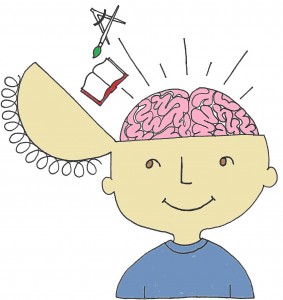Do you have a budding artist, architect, or engineer in your house? A little one who builds forts or fairy houses in the back yard, plays happily with LEGOs for hours on end, or draws with incredible detail but cries in frustration because it “still doesn’t look right” (when it looks perfectly fine to you)? If so, you may have a child with high visual/spatial intelligence.
People with visual and/or spatial genius have great imaginations. They can “see” the finished product in their minds before they ever pick up a pencil. Remember those test questions that ask, “If you fold this shape, which box will it look like?” They can figure those out fairly quickly, because they’re adept at visualizing and manipulating images. They have heightened spatial awareness (which sometimes translates into a “bat-like” sense of navigation. They rarely get lost but may actually feel dizzy for a while if you rearrange the furniture.) These guys have an unusual awareness of lines, shapes, and forms that naturally expresses itself through designing, drawing, or doodling.
The gift comes naturally, but they need practice and experience to make their plans a reality. Here are some activities that can help:
Let them play with puzzles and mazes.
Expose them to inspiring examples of art–not just museum-quality paintings and sculptures, but everyday art forms such as quilting or toy making.
Give them lots of art tools to experiment with–crayons, pens, pencils, paints, drawing paper, construction paper, watercolor, pastel chalks, clay, wood, textiles, and LEGOs. If possible, you might set aside a special shelf, drawer, closet, or even an under-bed storage container for craft supplies. You never know what art form may be “just right” for them.
Let them experiment with photography and video cameras, since art is not always static.
Play imaginative games. “If you can dream it, you can do it”…but first you have to dream it. Walt Disney called this “Imagineering”, and it takes time and practice. Daydreaming and playing ARE the work of children. 🙂




